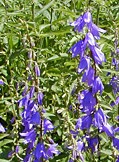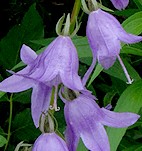 There are many bellflowers that are good garden plants but this is not one of them. Although the flowering stems are delightful and look lovely in a vase, the plant is so aggressive that is considered an invasive weed. It was introduced to North America from Europe as an ornamental but escaped from gardens and is now found in most of the United States. It likes partial shade, dry to moist sites with fertile, loamy soil. It is common in fields, pastures, woodlands, roadsides, gardens and lawns.
There are many bellflowers that are good garden plants but this is not one of them. Although the flowering stems are delightful and look lovely in a vase, the plant is so aggressive that is considered an invasive weed. It was introduced to North America from Europe as an ornamental but escaped from gardens and is now found in most of the United States. It likes partial shade, dry to moist sites with fertile, loamy soil. It is common in fields, pastures, woodlands, roadsides, gardens and lawns.
 Description: Seedlings appear in spring or fall and have heart-shaped leaves that grow from a central crown.
Description: Seedlings appear in spring or fall and have heart-shaped leaves that grow from a central crown.  In late spring a central erect stem develops and grows from two-four feet tall. The stem is slightly branched, light green to reddish brown and angular. It bleeds a milky juice when broken. The medium to dark green leaves on the stem are lanceolate to elongated heart-shaped, alternate, toothed, and 5” x 2” in size. The ones are the lower and mid stem are on slender petioles while the upper leaves are usually sessile. The nodding bell-shaped purple-blue
In late spring a central erect stem develops and grows from two-four feet tall. The stem is slightly branched, light green to reddish brown and angular. It bleeds a milky juice when broken. The medium to dark green leaves on the stem are lanceolate to elongated heart-shaped, alternate, toothed, and 5” x 2” in size. The ones are the lower and mid stem are on slender petioles while the upper leaves are usually sessile. The nodding bell-shaped purple-blue  flowers are borne in racemes up to one foot long from summer into fall and are followed by the production of seedpods with several small brown seeds with wings or ridges for wind dispersal. A single plant is capable of producing up to 15,000 seeds. The root system consists of a taproot with rhizomes that form tubers.
flowers are borne in racemes up to one foot long from summer into fall and are followed by the production of seedpods with several small brown seeds with wings or ridges for wind dispersal. A single plant is capable of producing up to 15,000 seeds. The root system consists of a taproot with rhizomes that form tubers.

 Control: Control of creeping bellflower is difficult because of the prodigious seed production and rhizomatous root system. It is almost impossible to hand pull or dig out because even a small piece of the root left in the ground may produce a new plant. Cutting the flowers (and using them in the vase) is necessary to reduce seed production. Chemical control is also difficult but several applications of non-selective herbicides such as glyphosate can be effective.
Control: Control of creeping bellflower is difficult because of the prodigious seed production and rhizomatous root system. It is almost impossible to hand pull or dig out because even a small piece of the root left in the ground may produce a new plant. Cutting the flowers (and using them in the vase) is necessary to reduce seed production. Chemical control is also difficult but several applications of non-selective herbicides such as glyphosate can be effective.